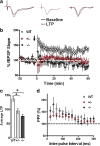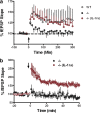CX3CR1 deficiency leads to impairment of hippocampal cognitive function and synaptic plasticity
- PMID: 22072675
- PMCID: PMC3236509
- DOI: 10.1523/JNEUROSCI.3667-11.2011
CX3CR1 deficiency leads to impairment of hippocampal cognitive function and synaptic plasticity
Abstract
The protective/neurotoxic role of fractalkine (CX3CL1) and its receptor CX3C chemokine receptor 1 (CX3CR1) signaling in neurodegenerative disease is an intricate and highly debated research topic and it is becoming even more complicated as new studies reveal discordant results. It appears that the CX3CL1/CX3CR1 axis plays a direct role in neurodegeneration and/or neuroprotection depending on the CNS insult. However, all the above studies focused on the role of CX3CL1/CX3CR1 signaling in pathological conditions, ignoring the relevance of CX3CL1/CX3CR1 signaling under physiological conditions. No approach to date has been taken to decipher the significance of defects in CX3CL1/CX3CR1 signaling in physiological condition. In the present study we used CX3CR1⁻/⁻, CX3CR1⁺/⁻, and wild-type mice to investigate the physiological role of CX3CR1 receptor in cognition and synaptic plasticity. Our results demonstrate for the first time that mice lacking the CX3CR1 receptor show contextual fear conditioning and Morris water maze deficits. CX3CR1 deficiency also affects motor learning. Importantly, mice lacking the receptor have a significant impairment in long-term potentiation (LTP). Infusion with IL-1β receptor antagonist significantly reversed the deficit in cognitive function and impairment in LTP. Our results reveal that under physiological conditions, disruption in CX3CL1 signaling will lead to impairment in cognitive function and synaptic plasticity via increased action of IL-1β.
Figures







Similar articles
-
Involvement of CX3CL1/CX3CR1 in depression and cognitive impairment induced by chronic unpredictable stress and relevant underlying mechanism.Behav Brain Res. 2020 Mar 2;381:112371. doi: 10.1016/j.bbr.2019.112371. Epub 2019 Nov 22. Behav Brain Res. 2020. PMID: 31765724
-
Phospholipase d2 ablation ameliorates Alzheimer's disease-linked synaptic dysfunction and cognitive deficits.J Neurosci. 2010 Dec 8;30(49):16419-28. doi: 10.1523/JNEUROSCI.3317-10.2010. J Neurosci. 2010. PMID: 21147981 Free PMC article.
-
PI3Kγ is required for NMDA receptor-dependent long-term depression and behavioral flexibility.Nat Neurosci. 2011 Oct 23;14(11):1447-54. doi: 10.1038/nn.2937. Nat Neurosci. 2011. PMID: 22019731
-
Genetically enhancing the expression of chemokine domain of CX3CL1 fails to prevent tau pathology in mouse models of tauopathy.J Neuroinflammation. 2018 Sep 25;15(1):278. doi: 10.1186/s12974-018-1310-6. J Neuroinflammation. 2018. PMID: 30253780 Free PMC article.
-
Brain-derived neurotrophic factor modulates the severity of cognitive alterations induced by mutant huntingtin: involvement of phospholipaseCgamma activity and glutamate receptor expression.Neuroscience. 2009 Feb 18;158(4):1234-50. doi: 10.1016/j.neuroscience.2008.11.024. Epub 2008 Nov 21. Neuroscience. 2009. PMID: 19121372
Cited by
-
Contribution of Pro-Inflammatory Molecules Induced by Respiratory Virus Infections to Neurological Disorders.Pharmaceuticals (Basel). 2021 Apr 8;14(4):340. doi: 10.3390/ph14040340. Pharmaceuticals (Basel). 2021. PMID: 33917837 Free PMC article. Review.
-
Characterizing newly repopulated microglia in the adult mouse: impacts on animal behavior, cell morphology, and neuroinflammation.PLoS One. 2015 Apr 7;10(4):e0122912. doi: 10.1371/journal.pone.0122912. eCollection 2015. PLoS One. 2015. PMID: 25849463 Free PMC article.
-
Targeting innate immunity for neurodegenerative disorders of the central nervous system.J Neurochem. 2016 Sep;138(5):653-93. doi: 10.1111/jnc.13667. J Neurochem. 2016. PMID: 27248001 Free PMC article. Review.
-
The multiple faces of extracellular vesicles released by microglia: Where are we 10 years after?Front Cell Neurosci. 2022 Sep 13;16:984690. doi: 10.3389/fncel.2022.984690. eCollection 2022. Front Cell Neurosci. 2022. PMID: 36176630 Free PMC article. Review.
-
Integrating neuroimmune systems in the neurobiology of depression.Nat Rev Neurosci. 2016 Aug;17(8):497-511. doi: 10.1038/nrn.2016.69. Epub 2016 Jun 9. Nat Rev Neurosci. 2016. PMID: 27277867 Review.
References
-
- Aloisi F. Immune function of microglia. Glia. 2001;36:165–179. - PubMed
-
- Batchelor PE, Liberatore GT, Wong JY, Porritt MJ, Frerichs F, Donnan GA, Howells DW. Activated macrophages and microglia induce dopaminergic sprouting in the injured striatum and express brain-derived neurotrophic factor and glial cell line-derived neurotrophic factor. J Neurosci. 1999;19:1708–1716. - PMC - PubMed
-
- Bazan JF, Bacon KB, Hardiman G, Wang W, Soo K, Rossi D, Greaves DR, Zlotnik A, Schall TJ. A new class of membrane-bound chemokine with a CX3C motif. Nature. 1997;385:640–644. - PubMed
-
- Beffert U, Weeber EJ, Durudas A, Qiu S, Masiulis I, Sweatt JD, Li WP, Adelmann G, Frotscher M, Hammer RE, Herz J. Modulation of synaptic plasticity and memory by Reelin involves differential splicing of the lipoprotein receptor Apoer2. Neuron. 2005;47:567–579. - PubMed
Publication types
MeSH terms
Substances
Grants and funding
LinkOut - more resources
Full Text Sources
Other Literature Sources
Molecular Biology Databases
Research Materials
Miscellaneous
